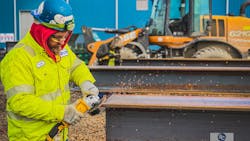Editor's note: This story first appeared in the 2023 Offshore Wind Special Report, which published within the September/October 2023 issue of Offshore magazine.
By Heather Gramm, Maryland Department of Commerce
Offshore wind is Maryland’s largest renewable energy resource, and it is proving to be a crucial time for the state in terms of clean energy and decarbonization goals. Under the Promoting Offshore Wind Energy Resources (POWER) Act, Maryland Gov. Wes Moore is significantly increasing the state’s offshore wind output and prioritizing wind energy partnerships to achieve 100% clean energy by 2035 while quadrupling offshore wind energy from about 2 GW to 8.5 GW, enough to power nearly three million homes.
With Ørsted and US Wind, Maryland is home to two of the nation’s leading offshore wind developers, making it a core hub of manufacturing and logistical activity for the industry as a whole. But what really sets Maryland apart are its minority-owned businesses that have become key players in the offshore wind supply chain thanks to legislation passed a decade ago.
Business infrastructure revolves around MBEs
This ensured that Maryland would use much of its own offshore resources, creating a self-sustaining business infrastructure, while also placing minority business enterprises (MBEs) at the forefront of its offshore movement.
With the state’s support, MBEs have brought enthusiasm, expertise and diversity to the industry. Crystal Steel Fabricators Inc., Arcon Training Center and Strum Contracting Co. Inc. were active in Maryland’s offshore wind movement from the beginning, testifying in the state’s capital as the 2013 legislation was passed. These MBEs are now engaged in Maryland’s key offshore wind projects with Ørsted and US Wind, which will produce more than 2,000 MW of total energy—enough to power 600,000 homes and provide more than 15,000 in-state jobs.
MBEs transforming offshore wind scene
Crystal Steel Fabricators Inc. is Asian-American owned, and the East Coast’s leading AISC-certified (American Institute of Steel Construction) minority-owned steel fabricator producing Maryland’s offshore wind structures. The MBE has heavily invested in advanced fabrication and paint technology, giving it a first-mover advantage in the industry, and is one of the only domestic suppliers of offshore wind secondary steel components. Given its production commitments to Ørsted and US Wind, and the burgeoning opportunities in offshore wind, Crystal Steel plans to double its capacity, creating more than 200 highly skilled Maryland-based jobs in the next five years.
While Crystal Steel produces the steel and the structures, Strum Contracting Co. Inc.—a black- and woman-owned heavy civil infrastructure contractor—focuses on the installation of these structures, plus the infrastructure upgrades of the ports. Additionally, the company frequently partners with trade schools and other organizations to create a strong local workforce.
Providing workers to both of these MBEs is Arcon Training Center, a women-owned business and one of the first facilities in the US offering Global Wind Organisation training courses and refreshers. Arcon is one of the only East Coast sites that offers the safety training needed for a career in the offshore and wind energy industry. It also provides consulting services to help create offshore wind training programs and sources safety training equipment. The MBE has seen that many professionals prefer Maryland because of the strong work-life balance the state offers, and the ability to have long-term career paths within the industry.
All three MBEs work closely with one another, along with Ørsted and US Wind, to create a powerhouse ecosystem in Maryland for its renewable energy projects. These MBEs are written into the fabric of the state’s industry and are recognized as leaders in propelling offshore wind nationwide, making Maryland a model for other states to develop their own infrastructure to support offshore wind goals.





